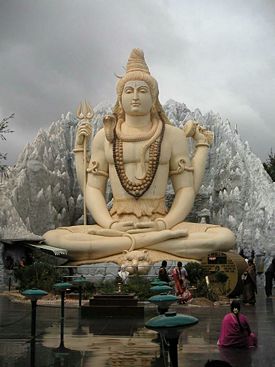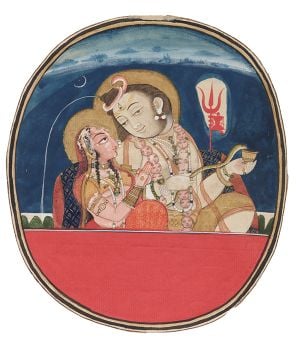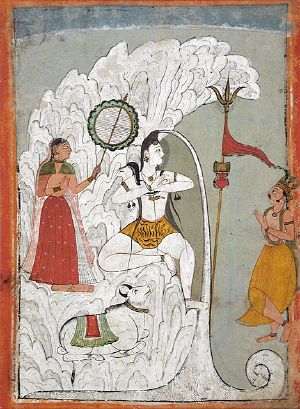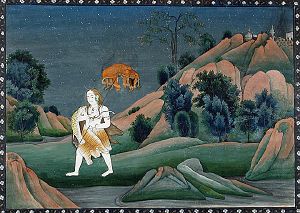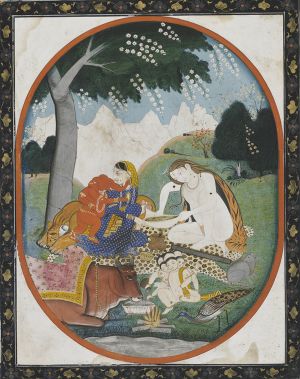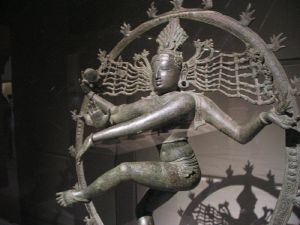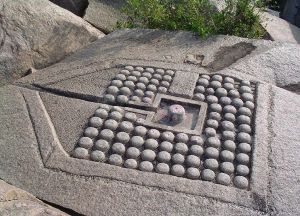Shiva
- For other uses, see Shiva (disambiguation).
Template:IndicTextRight
| ||||||||||||||||||
Shiva (pronunciation: [ʃɪ.ʋə]; Sanskrit: शिव, Śiva, lit. "Auspicious one") is one of the principal deities of Hinduism. Within Shaivism he is viewed as the Supreme deity, whereas in other branches of Hinduism such as the Smarta tradition he is worshipped as one of the six manifestations of the Divine. Followers of Hinduism who focus their worship upon Shiva are called Shaivites or Shaivas (Sanskrit Śaiva).[2] His role as the primary deity of Shaivism is reflected in his epithets Mahādeva ("great god"; mahā = great + deva = god),[3][4] Maheśvara ("great lord"; mahā = great + īśvara = lord),[5][6] and Parameśvara ("Supreme Lord").[7] Shaivism, along with Vaiṣṇava traditions that focus on Vishnu, and Śākta traditions that focus on the goddess (Devī) are three of the most influential denominations in Hinduism.[8]
Shiva is one of the six primary forms of the Divine in Smartism, a denomination of Hinduism that puts particular emphasis on six deities, the other five being Vishnu, Shakti, Ganesha, Kartikkeya and Surya.[9] Another way of thinking about the divinities in Hinduism identifies Brahma, Vishnu, and Shiva as each representing one of the three primary aspects of the divine in Hinduism, known collectively as the Trimurti. In the Trimurti system, Brahma is the creator, Vishnu is the maintainer or preserver, and Shiva is the destroyer or transformer.[10]
Shiva is usually worshipped as the Shiva linga. In images, he is generally represented as immersed in deep meditation or dancing the Tandava upon the demon of ignorance in his manifestation of Nataraja, the lord of the dance.
Etymology
The Sanskrit word śiva or Shivam (Devanagari िशव) is an adjective meaning kind, friendly, gracious, or auspicious.[11][12] As a proper name it means "The Auspicious One", used as a euphemistic name for Rudra.[13] In simple English transliteration it is written either as Shiva or Siva. Pronunciation is written in the International Phonetic Alphabet as IPA: [ɕivə]. The adjective śiva meaning "auspicious" is used as an attributive epithet not particularly of Rudra, but of several other Vedic deities.[14] In the Rig Veda, Indra uses this word to describe himself several times. (2:20:3, 6:45:17, 8:93:3)
In Tamil Siva literally means "the supreme one". Adi Sankara in his interpretation of the name Shiva, the 27th and 600th name of Vishnu sahasranama interprets Shiva to mean either "The Pure One," i.e., the One who is not affected by three Gunas of Prakrti, Sattva, Rajas and Tamas. or "the One who purifies everyone by the very utterance of His name." [15] Swami Chinmayananda, in his translation of Vishnu sahasranama further elaborates on that verse: Shiva means the One who is eternally pure, or the One who can never have any contamination of the imperfection of Rajas and Tamas [16]
The Sanskrit word śaiva means "relating to the god Shiva", and this term is the Sanskrit name both for one of the principal sects of Hinduism, and for a member of one of those sects.[17] It is used as an adjective to characterize certain beliefs and practices, such as Shaivism.[18]
The name Shiva, in one interpretation, is also said to have derived from the Dravidian word “Siva” meaning “to be red”. It is the equivalent of Rudra, “the red” RigVeda.[19]
Historical development
- For the early history, see Rudra.
The worship of Shiva is a pan-Hindu tradition, practiced widely across all of India, Nepal and Sri Lanka.[20][21] Modern historians believe that the figure of Shiva as we know him today was built-up over time, with the ideas of many regional sects being amalgamated into a single figure.[22] How the persona of Shiva converged as a composite deity is not well-documented.[23] Axel Michaels explains the composite nature of Shaivism as follows:
Like Vişņu, Śiva is also a high god, who gives his name to a collection of theistic trends and sects: Śaivism. Like Vaişņavism, the term also implies a unity which cannot be clearly found either in religious practice or in philosophical and esoteric doctrine. Furthermore, practice and doctrine must be kept separate.[24]
An example of assimilation took place in Maharashtra, where a regional deity named Khandoba is a patron deity of farming and herding castes.[25] The foremost center of worship of Khandoba in Maharashtra is in Jejuri.[26] Khandoba has been assimilated both as a name for Karttikya[27] and also as a form of Shiva himself[28] in which case he is worshipped in the form of a lingam.[29][30] Khandoba's varied associations also include an indentification with Surya.[31] The derivation of the name Khandoba has been variously interpreted, and M. S. Mate says that the most commonly-held belief is that it was a distorted form of Skanda, but also notes alternate theories.[32]
The Pashupati seal
A seal discovered during excavation of the Mohenjo-daro archaeological site in the Indus Valley has drawn attention as a possible representation of a "proto-Shiva" figure.[33] This "Pashupati" (Lord of Animals,or Lord of Beings Sanskrit paśupati)[34] seal shows a seated figure, possibly ithyphallic, surrounded by animals.[35] Sir John Marshall and others have claimed that this figure is a prototype of Shiva, and have described the figure as having three faces, seated in a "yoga posture" with the knees out and feet joined.
This claim has not fared well with some modern academics. Gavin Flood characterizes these views as "speculative", saying that while it is not clear from the seal that the figure has three faces, is seated in a yoga posture, or even that the shape is intended to represent a human figure, it is nevertheless possible that there are echoes of Shaiva iconographic themes, such as half-moon shapes resembling the horns of a bull.[36][37] Historian John Keay is more specifically dismissive, saying:
...there is little evidence for the currency of this myth. Rudra, a Vedic deity later identified with Shiva, is indeed referred to as pasupati because of his association with cattle; but asceticism and meditation were not Rudra's specialties, nor is he usually credited with an empathy for animals other than kine. More plausibly, it has been suggested that the Harappan figure's heavily horned headgear bespeaks a bull sect, to which numerous other representations of bulls lend substance.[38]
Rudra
Shiva as we know him today shares many features with the Vedic god Rudra[39] and both Shiva and Rudra are viewed as the same personality in a number of Hindu traditions. Rudra, the god of the roaring storm, is usually portrayed in accordance with the element he represents as a fierce, destructive deity.
The oldest surviving text of Hinduism is the Rig Veda, which is dated to between 1700–1100 B.C.E. based on linguistic and philological evidence.[40] A god named Rudra is mentioned in the Rig Veda. The name Rudra is still used as a name for Shiva. In RV 2.33 he is described as the "Father of the Maruts", a group of storm gods.[41] Furthermore, the Rudram, one of the most sacred hymns of Hinduism found both in the Rig and the Yajur Vedas, and addressed to Rudra, invokes him as Shiva in several instances.
The identification of Shiva with the older god Rudra is not universally accepted, as Axel Michaels explains:
To what extent Śiva's origins are in fact to be sought in Rudra is extremely unclear. The tendency to consider Śiva an ancient god is based on this identification, even though the facts that justify such a far-reaching assumption are meager.[42]
Rudra is called "The Archer" (Sanskrit: Śarva)[43] and the arrow is an essential attribute of Rudra.[44] This name appears in the Shiva Sahasranama, and R. K. Sharma notes that it is used as a name of Shiva often in later languages.[45] The word is derived from the Sanskrit root śarv- which means "to injure" or "to kill"[46] and Sharma uses that general sense in his interpretive translation of the name Śarva as "One who can kill the forces of darkness".[47] The names Dhanvin ("Bowman")[48] and Bāṇahasta ("Archer", literally "Armed with arrows in his hands")[49][50] also refer to archery.
Identification with Vedic deities
Shiva's rise to a major position in the pantheon was facilitated by his identification with a host of Vedic deities, including Agni, Indra, Prajāpati, Vāyu, and others.[51]
Agni
Rudra and Agni have a close relationship.[52][53] The identification between Agni and Rudra in the Vedic literature was an important factor in the process of Rudra's gradual development into the later character as Rudra-Shiva.[54] The identification of Agni with Rudra is explicitly noted in the Nirukta, an important early text on etymology, which says "Agni is called Rudra also".[55] The interconnections between the two deities are complex, and according to Stella Kramrisch:
The fire myth of Rudra-Śiva plays on the whole gamut of fire, valuing all its potentialities and phases, from conflagration to illumination.[56]
In the Śatarudrīa, some epithets of Rudra such as Sasipañjara ("Of golden red hue as of flame") and Tivaṣīmati ("Flaming bright") suggest a fusing of the two deities.[57] Agni is said to be a bull[58] and Lord Shiva possesses a bull as his vehicle, Nandi. The horns of Agni, who is sometimes characterized as a bull, are mentioned.[59][60] In medieval sculpture both Agni and the form of Shiva known as Bhairava have flaming hair as a special feature.[61]
Indra
The Indologist, Koenraad Elst proposes that Shiva of Puranic Hinduism is a continuation of the Vedic Indra.[citation needed] He gives several reasons for his hypothesis. Both Shiva and Indra are known for having a thirst for Soma. Both are associated with mountains, rivers, male fertility, fierceness, fearlessness, warfare, transgression of established mores, the Aum sound, the Supreme Self. In the Rig Veda the term śiva is used to refer to Indra. (2.20.3,[62] 6.45.17,[63][64] and 8.93.3.[65])
Indra, like Shiva, is likened to a bull.[66][67]
Indra is likened to a white elephant named 'Airavat' instead of the bull. The two deity are separate from each other.
In the Rig Veda, Rudra is the father of the Maruts, but he is never associated with their warlike exploits as is Indra.[68]
Attributes of Shiva
- Third Eye: Shiva is often depicted with a third eye with which he burned Desire (Kāma) to ashes.[69] There has been controversy regarding the original meaning of Shiva's name Tryambakam (Sanskrit: त्र्यम्बकम्), which occurs in many scriptural sources.[70] In classical Sanskrit the word ambaka denotes "an eye", and in the Mahabharata Shiva is depicted as three-eyed, so this name is sometimes translated as "Having Three Eyes".[71] However, in Vedic Sanskrit the word ambā or ambikā means "mother", and this early meaning of the word is the basis for the translation "Having Three Mothers" that was used by Max Müller and Arthur Macdonell.[72][73] Since no story is known in which Shiva had three mothers, E. Washburn Hopkins suggested that the name refers not to three mothers, but to three Mother-goddesses who are collectively called the Ambikās.[74] Other related translations have been "having three wives or sisters", or based on the idea that the name actually refers to the oblations given to Rudra, which according to some traditions were shared with the goddess Ambikā.[75]
- Blue Throat: The epithet Nīlakaṇtha (Sanskrit नीलकण्ठ; nīla = blue, kaṇtha = throat)[76][77] refers to a story in which Shiva drank the poison churned up from the world ocean.[78][79] (see: Halāhala)
- Crescent Moon: Shiva bears on his head the crescent of the moon.[80] The epithet Chandraśekhara (Sanskrit: चन्द्रशेखर "Having the moon as his crest" - chandra = Moon, śekhara = crest, crown)[81][82][83] refers to this feature. The placement of the moon on his head as a standard iconographic feature dates to the period when Rudra rose to prominence and became the major deity Rudra-Shiva.[84] The origin of this linkage may be due to the identification of the moon with Soma, and there is a hymn in the Rig Veda where Soma and Rudra are jointly emplored, and in later literature Soma and Rudra came to be identified with one another, as were Soma and the Moon.[85]
- Matted Hair: Shiva's distinctive hair style is noted in the epithets Jaṭin, "The One with matted hair"[86] and Kapardin, "Endowed with matted hair"[87] or "wearing his hair wound in a braid in a shell-like (kaparda) fashion".[88] A kaparda is a cowrie shell, or a braid of hair in the form of a shell, or more generally hair that is shaggy or curly.[89]
- Sacred Ganga: The Ganga river flows from the matted hair of Shiva. The epithet Gaṅgādhara ("Bearer of the river Gaṅgā") refers to this feature.[90][91] The Ganga (Ganges), one of the major rivers of the country, is said to have made her abode in Shiva's hair.[92] The legend of Bhagiratha states that when the sage of that name invoked the gods to send the divine Ganges to earth to relieve a drought and purify the remains of his ancestors, he was warned that the earth had not the capacity to withstand the descent of the Ganges from heaven, in pursuit of which he propitiated Siva to receive the Ganges upon her descent from heaven and release her with diminished force. Siva agreed to trap the youthful and mischievous Ganges in his matted locks and release her to the earth. It was thus, according to Hindu legend, that the Ganges came to be trapped in Siva's locks, and to be portrayed as flowing therefrom, in all representations of Siva.[citation needed]
- Ashes: Shiva smears his body with ashes (bhasma).[93] Some forms of Shiva, such as Bhairava, are associated with a very old Indian tradition of cremation-ground asceticism that was practiced by some groups who were outside the fold of brahmanic orthodoxy.[94] These practices associated with cremation grounds are also mentioned in the Pali canon of Theravada Buddhism.[95] One epithet for Shiva is "Inhabitant of the cremation ground" (Sanskrit: śmaśānavāsin, also spelled Shmashanavasin) referring to this connection.[96]
- Tiger skin: He is often shown seated upon a tiger skin,[97] an honour reserved for the most accomplished of Hindu ascetics, the Brahmarishis. Mythology ~ The birth of Brahmarishis (HTML). Retrieved 2008-05-07.
- Serpents: Shiva is often shown garlanded with a snake.[98]
- Trident: (Sanskrit: Trishula) Shiva's particular weapon is the trident.[99]
- Drum: A small drum shaped like an hourglass is known as a damaru (Sanskrit: ḍamaru).[100][101] This is one of the attributes of Shiva in his famous dancing representation[102] known as Nataraja. A specific hand gesture (mudra) called ḍamaru-hasta (Sanskrit for "ḍamaru-hand") is used to hold the drum.[103] This drum is particularly used as an emblem by members of the Kāpālika sect.[104]
- Nandī, also known as Nandin, is the name of the bull that serves as Shiva's mount (Sanskrit: vāhana).[105][106] Shiva's association with cattle is reflected in his name Paśupati or Pashupati (Sanskrit पशुपति), translated by Sharma as "Lord of cattle"[107] and by Kramrisch as "Lord of Animals", who notes that it is particularly used as an epithet of Rudra.[108]
- Gaṇa : In Hinduism, the Gaṇas (Devanagari: गण) are attendants of Shiva and live in Kailasa. They are often referred to as the Boothaganas, or ghostly hosts, on account of their nature. Generally benign, except when their Lord is transgressed against, they are often invoked to intercede with the Lord on behalf of the devotee. Ganesha was chosen as their leader by Shiva, hence Ganesha's title gaṇa-īśa or gaṇa-pati, "lord of the gaṇas".[109]
- Mount Kailāsa in the Himalayas is his traditional abode.[110] In Hindu mythology, Mount Kailāsa is conceived as resembling a Linga, representing the center of the universe.[111]
- Varanasi (Benares) is considered as the city specially-loved by Shiva, and is one of the holiest places of pilgrimage in India. It is referred to, in religious contexts, as Kashi.[112]
Forms and depictions
According to Gavin Flood, "Śiva is a god of ambiguity and paradox", whose attributes include opposing themes.[113] The ambivalent nature of this deity is apparent in some of his names and the stories told about him.
Destroyer versus benefactor
In the Yajurveda two contrary sets of attributes for both malignant or terrific (Sanskrit: rudra) and benign or auspicious (Sanskrit: śiva) forms can be found, leading Chakravarti to conclude that "all the basic elements which created the complex Rudra-Śiva sect of later ages are to be found here."[114] In the Mahabharata, Shiva is depicted as "the standard of invincibility, might, and terror", as well as a figure of honor, delight, and brilliance.[115] The duality of Shiva's fearful and auspicious attributes appears in contrasted names.
The name Rudra (Sanskrit रुद्र) reflects his fearsome aspects. According to traditional etymologies, the Sanskrit name Rudra is derived from the root rud- which means "to cry, howl."[116] Stella Kramrisch notes a different etymology connected with the adjectival form raudra, which means wild, of rudra nature, and translates the name Rudra as "the Wild One" or "the Fierce God".[117] R. K. Sharma follows this alternate etymology and translates the name as "Terrible".[118] Hara (Sanskrit हर) is an important name that occurs three times in the Anushasanaparvan version of the Shiva sahasranama, where it is translated in different ways each time it occurs, following a commentorial tradition of not repeating an interpretation. Sharma translates the three as "One who captivates", "One who consolidates", and "One who destroys."[119] Kramrisch translates it as "The Ravisher".[120] Another of Shiva's fearsome forms is as Kāla (Sanskrit: काल), "Time", and as Mahākāla (Sanskrit: महाकाल), "Great Time", which ultimately destroys all things.[121][122][123] Bhairava (Sanskrit: भैरव), "Terrible" or "Frightful"[124] is a fierce form associated with annihilation.[125]
In contrast, the name Śaṇkara (Sanskrit शङ्कर), "Beneficent"[126] or "Conferring Happiness"[127] reflects his benign form. This name was adopted by the great Vedanta philosopher Śaṇkara (c. 788-820 C.E.), who is also known as Shankaracharya.[128][129] The name Śambhu (Sanskrit: शम्भु), "Causing Happiness", also reflects this benign aspect.[130][131]
Ascetic versus householder
He is depicted as both an ascetic yogin and as a householder, roles which are mutually exclusive in Hindu society.[132] When depicted as a yogin he may be shown sitting and meditating.[133] His epithet Mahāyogin (The Great Yogi: Mahā = great, Yogin = one who practices Yoga) refers to his association with yoga.[134] While Vedic religion was conceived mainly in terms of sacrifice, it was during the Epic period that concepts of tapas, yoga, and asceticism, became more important, and the depiction of Shiva as an ascetic sitting in philosophical isolation reflects these later concepts.[135]
As a family man and householder he has a wife, Parvati (also known as Umā), and two sons, Ganesha and Skanda. His epithet Umāpati ("The husband of Umā") refers to this idea, and Sharma notes that two other variants of this name that mean the same thing, Umākānta and Umādhava, also appear in the sahasranama.[136] Umā in epic literature is known by many names, including Pārvatī.[137][138] She is identified with Devi, the Divine Mother, and with Shakti (divine energy).
Shiva and Parvati are the parents of Karthikeya and Ganesha. Karthikeya is worshipped in southern India (especially in Tamil Nadu and Karnataka) by the names Subrahmanyan, Shanmughan, Swaminathan and Murugan, and in northern India, is better known by the names Skanda, Kumara, or Karttikeya.[139]
Nataraja
The depiction of Shiva as Nataraja (Tamil: நடராஜா, Sanskrit: naṭarāja, "Lord of Dance") is popular.[140][141] The names Nartaka ("Dancer") and Nityanarta ("Eternal Dancer") appear in the Shiva Sahasranama.[142] His association with dance and also with music is prominent in the Puranic period.[143] In addition to the specific iconographic form known as Nataraja, various other types of dancing forms (Sanskrit: nṛtyamūrti) are found in all parts of India, with many well-defined varieties in Tamil Nadu (in southern India) in particular.[144]
Dakṣiṇāmūrti
Dakṣiṇāmūrti (Sanskrit: दक्षिणामूर्ति)[145] literally describes a form (mūrti) of Shiva facing south (dakṣiṇa). This form represents Shiva in his aspect as a teacher of yoga, music, and wisdom, and giving exposition on the shastras.[146] This iconographic form for depicting Shiva in Indian art is mostly from Tamil Nadu.[147] Elements of this motif can include Shiva seated upon a deer-throne and surrounded by sages who are receiving his instruction.[148]
Mruthyunjaya
Literally translated as 'victor over death', this is an aspect of Shiva worshipped as the conqueror of Death as manifested in the Hindu lord of death, Yama. The particular legend in question deals with the sage Markandeya, who was fated to die at the age of sixteen. On account of the sage's worship and devotion to Shiva, the Lord vanquished Yama to liberate his devotee from death. Shiva is often worshipped as Mruthyunjaya by the aged or ill, to ward off death and mitigate its harshness when it does occur. He is worshipped as such at the temples of Thirupainyeeli, near Trichinopoly, and at a shrine in Thirukadaiyur, near Chidambaram.
Ardhanarishvara
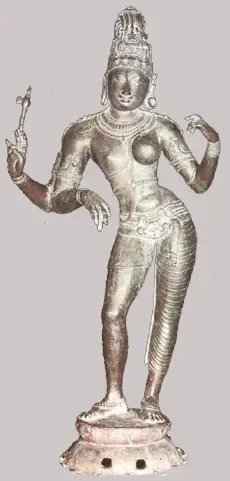
An iconographic representation of Shiva called Ardhanarishvara shows him with one half of the body as male, and the other half as female.[149] According to Ellen Goldberg, the traditional Sanskrit name for this form, (Ardhanārīśvara) is best translated as "the lord who is half woman", and not as "half-man, half-woman".[150]
Tripurāntaka
Shiva is often depicted as an archer in the act of destroying the triple fortresses, Tripura, of the Asuras.[151] Shiva's name Tripurāntaka (Sanskrit: त्रिपुरान्तक), "Ender of Tripura", refers to this important story.[152]
Lingam
Apart from anthropomorphic images of Shiva, the worship of Shiva in the form of a lingam is also important.[153][154][155] These are depicted in various forms. One common form is the shape of a vertical rounded column.
The five mantras
Five is a sacred number for Shiva.[156] One of his most important mantras has five syllables (namaḥ śivāya).[157]
Shiva's body is said to consist of five mantras, called the pañcabrahmans:[158] As forms of god, each of these have their own names and distinct iconography:[159]
These are represented as the five faces of Shiva, and are associated in various texts with the five elements, the five senses, the five organs of perception, and the five organs of action.[160][161] Doctrinal differences and possibly errors in transmission have resulted in some differences between texts in details of how these five forms are linked with various attributes.[162] But the overall meaning of these associations is summarized by Stella Kramrisch:
Through these transcendent categories, Śiva, the ultimate reality, becomes the efficient and material cause of all that exists.[163]
According to the Pañcabrahma Upanishad:
One should know all things of the phenomenal world as of a fivefold character, for the reason that the eternal verity of Śiva is of the character of the fivefold Brahman. (Pañcabrahma Upanishad 31)[164]
Relationship to Vishnu
During the Vedic period, both Vishnu and Shiva (as identified with Rudra) played relatively minor roles, but by the time of the Brahmanas (c. 1000-700 B.C.E.) both were gaining ascendance.[165] By the Puranic period both deities had major sects that competed with one another for devotees.[166] Many stories developed showing different types of relationships between these two important deities.
Sectarian forces each presented their own preferred deity as supreme. Vishnu in his myths "becomes" Shiva.[167] The Vishnu Purana (4th c. CE) shows Vishnu awakening and becoming both Brahmā to create the world, and Shiva to destroy it.[168] Shiva also is viewed as a manifestation of Vishnu in the Bhagavata Purana.[169] In Shaivite myths, on the other hand, Shiva comes to the fore and acts independently and alone to create, preserve, and destroy the world.[170] In one Shaivite myth of the origin of the lingam, both Vishnu and Brahmā are revealed as emanations from Shiva's manifestation as a towering pillar of flame.[171] The Śatarudrīya, a Shaivite hymn, says that Shiva is "of the form of Vishnu".[172] Difference in viewpoints between the two sects is apparent in the story of Śarabha (also spelled "Sharabha"), the name of Shiva's incarnation in the composite form of man, bird, and beast. Shiva assumed that unusual form to chastise Vishnu in his hybrid form as Narasimha, the man-lion, who killed Hiranyakashipu, an ardent devotee of Shiva.[173][174]
Syncretic forces produced stories in which the two deities were shown in cooperative relationships and combined forms. Harihara is a the name of a combined deity form of both Vishnu (Hari) and Shiva (Hara).[175] This dual form, which is also called Harirudra, is mentioned in the Mahabharata.[176] An example of a collaboration story is one given to explain Shiva's epithet Mahābaleśvara, "Lord of Great Strength" (Maha = great, Bala = strength, Īśvara = Lord). This name refers to story in which Rāvaṇa was given a linga as a boon by Shiva on the condition that he carry it always. During his travels, he stopped near the present Deoghar in Bihar to purify himself and asked Narada a devotee of Vishnu in the guise of a Brahmin to hold the linga for him, but after some time Narada put it down on the ground and vanished. When Ravana returned, he could not move the linga, and it is said to remain there ever since.[177]
Avatars
Shiva, like some other Hindu deities, is said to have several incarnations, known as Avatars. Adi Shankara, the 8th-century philosopher of non-dualist Vedanta was named "Shankara" after Lord Shiva and is considered to have been an incarnation of Shiva.[178] In the Hanuman Chalisa Hanuman is identified as the eleventh avatar of Shiva.[179]
Worship
In Shaivism, Shiva is the God of all and is worshipped by all, from Devas (gods) such as Brahma, Indra, by Asuras(demons) like Bana, Ravana, by humans like Adi Shankara, Nayanars, by creatures as diverse as Jatayu, an eagle, and Vali, an ape. Furthermore, people of different backgrounds and qualities worship Shiva with many temples having histories of even cranes, bees, elephants, (see Kalahasti), spiders, snakes, worshipping Shiva and getting blessed. It concludes that the Good Lord blesses anyone who worships him with sincere devotion as there is no discrimination based on the seeker. Although Lord Shiva loves His devotees equally and does not ignore the meditation even of demons such as the rakshasas and asuras, He always finds ways to protect righteousness and never allows any evil to triumph over good.
Major deities, rishis, planets, worshipped Shiva and established Shivalingas in various places.
- Pashupatinath Lord of all living beings, located at Kathmandu, Nepal.
- Somnath located at Prabhas Patan in Saurashtra in Gujarat.
- Dwarka in Gujarat is home to the Nageshwar Jyotirlinga temple.
- Mahakal, Ujjain (or Avanti) in Madhya Pradesh is home to the Mahakaleshwar Jyotirlinga temple.
- Srisailam - Srisailam near Kurnool enshrines Mallikarjuna in an ancient temple architecturally and sculpturally rich.
- Bhimashankar, in the Sahyadri range of Maharashtra, contains a Jyotirlinga shrine associated with Shiva destroying the demon Tripurasura.
- Omkareshwar in Madhya Pradesh is an island in the Narmada river, home to a Jyotirlinga shrine and the Amareshwar temple.
- Sukreswar Temple located on Sukreswar hill in Guwahati on the southern bank of Brahmaputra, with the ghat leading down to the river.
- Uma Nanda Temple located on the Peacock island in middle of River Brahmaputra in Guwahati.
- Kedarnath in Uttarakhand is the northernmost of the Jyotirlingas.
- Varanasi (Benares) in Uttar Pradesh is home to the Vishwanath Jyotirling temple.
- Trimbakeshwar, near Nashik in Maharashtra, has a Jyotirlinga shrine located associated with the origin of the Godavari river.
- Grishneshwar Jyotirlinga shrine, in Maharashtra, is located near the rock-cut temples of Ellora.
- Deoghar, in the Santhal Parganas region of Jharkhand, is home to the Vaidyanath Jyotirlinga temple.
- Ganesha worshipped Shiva at Pillayar patti (100 km from Madurai, India)
- The four Vedas worshipped Shiva at Thirumaraikaadu (i.e., Vedaaranyam near Tanjore)
- Skanda worshipped Shiva at Thiruchendur (200 km from Madurai, India)
- Rama (avatar of Vishnu) worshipped Shiva in Rameswaram(India)
- Vishnu worshipped Shiva atKanchipuram (Kachiswarar Temple)
- Parasurama (avatar of Vishnu) worshipped Shiva at Sreesailam, Karnataka and also at Chennai (Parasurama at Lingeshwara Temple, Iyanavaram)
- Goddess Lakshmi (wife of Vishnu) worshipped Shiva at Tirupachethi (50 km from Madurai).
- Surya worshipped Shiva at Srivilliputhur (Vaidhyanathaar Temple 100 km from Madurai)
- Brahma and Vishnu at Tiruvannamalai (180 km from Chennai)
- Brahma at Vrinchipuram (155 km from Chennai, 15 km from Vellore)
- Rahu and Ketu at Kaalahasthi (50 km from Tirupathi, Andhra Pradesh, India)
- Indra at Madurai (Soma Sundareeswar Temple)
- The Rishi Agastya at Papanasam (100 km from Tirunelveli, Tamil Nadu, India)
- Goddess Parvati at Kancheepuram (Ekambeeswarar Temple, 70 km from Chennai, India)
- Shani at Thirnallar (near Kaaraikal, Pondicherry)
- Moongod at Thingalur (near Tanjore)
- Shiva and Sani at Thirvidaimaruthoor (near Kumbakonam)
- Brahma at Kumbakoonam (Kumbeeswarar, near Tanjore)
- Ujjain Jyotirlinga shrine, in Madhya Pradesh.
- Lord Shiva at Trilochan, is famous with name of Trilochan Mhadev Temple, 30 km from varanasi , india
- Manjunatha - Lord of mist at Dharmasthala this one famous pilgrim of Dakshina Kannada,Karnataka.
- Nanjundeshwara - One who has gulped nanju-pain or Halahala in his throat or SriKanteshwara at Nanjangud near Mysore,Karnataka
- AtmaLinga at Gokarna ,Karnataka.
- Panchalingeshwara - 5 Lingas, all of which are covered with sand but opens up at specific dates at Talakad, Karnataka.
- Shivagange- Believed to be patalaGanga flowing by rishi Agastya worship. Bangalore, Karnataka.
- Murudeshwara in Uttara Kannada, Karnataka.
- Kudalasangama in Basavakalyana, Karnataka.
- By Lava and Kusha (sons of Rama) in Kurungaleeswar temple at Koyambedu Chennai.
- Bakreshwar and Tarakeshwar in West Bengal
In South India, five temples of Shiva are held to be particularly important, as being manifestations of him in the five elemental substances:
- Tiruvannamalai, as fire
- Chidambaram, as ether
- Srikalahasti, as air
- Tiruvanaikal, as water
- Conjeeveram, as earth
Names of Shiva
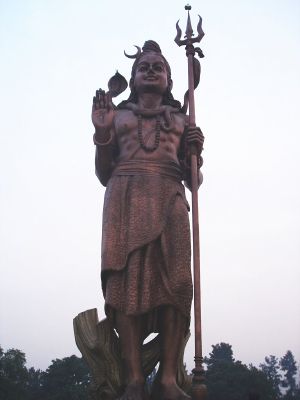
In Hinduism, deities are called by many names, which describe them in different ways. These names often refer to specific stories about the deities, functions they perform, or ways of thinking about them. Study of these names is helpful to understanding deities from multiple points of view. Some names are used by more than one deity, so looking for names that uniquely describe a deity is one way to pinpoint their functions.
Sahasranamas
There are at least eight different versions of the Shiva Sahasranama, devotional hymns (stotras) listing many names of Shiva.[180] The version appearing in Book 13 (Anuśāsanaparvan) of the Mahabharata is considered the kernel of this tradion.[181]
The nine versions of Shiva sahasranamas are
- 1. Mahabharata 13.17.30-150 (Anuśāsanaparvan Version)
- 2. 'Rudrayamala
- 3. Linga Purana (version 1, LP 1.65.54-168) is close to the Mahabharata Anuśāsanaparvan version.
- 4. Linga Purana (version 2, LP 1.98.27-159) has some passages in common with LP version 1, but also with other sources
- 5. Shivapurana 4.35.1-131.
- 6. Mahabharata (Śāntiparvan version). The critical edition of the Mahabharata does not include this version, relegating it to Appendix 28 to Śāntiparvan. It does appear in the text of the Gita Press edition as 12.284.68-180.
- 7. Vayu Purana (1.30.179-284) is almost the same as the Mahabharata Śāntiparvan version.
- 8. Brahmanda Purana (38.1.1-100) is almost the same as the Vayu Purana version.
- 9. Mahābhāgavata Upapurana (67.1-125) appears to be of comparatively recent origin.
Lord Shiva also has DashaSahasranamas (10,000 names) that are found in the Mahanyasa.
Rudram Chamakam
The Shri Rudram Chamakam, also known as the Śatarudriya, is a devotional hymn to Shiva hailing him by many names.[182][183]
Notes
- ↑ For the name Kailāsagirivāsī (Sanskrit कैलासगिरिवासी), "With his abode on Mount Kailāsa", as a name appearing in the Shiva Sahasranama, see: Sharma 1996, p. 281.
- ↑ Tattwananda, p. 45.
- ↑ Kramrisch, p. 476.
- ↑ For appearance of the name महादेव in the Shiva Sahasranama see: Sharma 1996, p. 297
- ↑ Kramrisch, p. 477.
- ↑ For appearance of the name महेश्वर in the Shiva Sahasranama see: Sharma 1996, p. 299.
- ↑ For Parameśvara as "Supreme Lord" see: Kramrisch, p. 479.
- ↑ Flood (1996), p. 17.
- ↑ Flood (1996), p. 17.
- ↑ Zimmer (1972) p. 124.
- ↑ Apte, p. 919.
- ↑ Macdonell, p. 314.
- ↑ Macdonell, p. 314.
- ↑ For use of the term śiva as an epithet for other Vedic deities, see: Chakravarti, p. 28.
- ↑ Sri Vishnu Sahasranama, Ramakrishna Math edition, pg.47 and pg. 122.
- ↑ Swami Chinmayananda's translation of Vishnu sahasranama, pg. 24, Central Chinmaya Mission Trust .
- ↑ Apte, p. 927
- ↑ For the definition "Śaivism refers to the traditions which follow the teachings of Śiva (śivaśāna) and which focus on the deity Śiva... " see: Flood (1996), p. 149.
- ↑ Encyclopedia of Indian Tribes By Shyam Singh Shashi, p. 190
- ↑ Flood (1996), p. 17
- ↑ Keay, p.xxvii.
- ↑ Keay, p. xxvii.
- ↑ For Shiva as a composite deity whose history is not well-documented, see: Keay, p. 147.
- ↑ Michaels, p. 215.
- ↑ Courtright, p. 205.
- ↑ For Jejuri as the foremost center of worship see: Mate, p. 162.
- ↑ For use of the name Khandoba as a name for Karttikeya in Maharashtra, see: Gupta, Preface, and p. 40.
- ↑ 'Khandoba: Ursprung, Geschiche und Umvelt von Pastoralem Gotheiten in Maharashtra, Wiesbaden 1976 (German with English Synopsis) pp. 180-98, "Khandoba is a local deity in Maharashtra and been Sanskritised as an incarnation of Shiva."
- ↑ Courtright, p. 205.
- ↑ For worship of Khandoba in the form of a lingam and possible identification with Shiva based on that, see: Mate, p. 176.
- ↑ Courtright, p. 205.
- ↑ Mate, p. 176.
- ↑ Flood (1996), pp. 28-29.
- ↑ For translation of paśupati as "Lord of Animals" see: Michaels, p. 312.
- ↑ For a drawing of the seal see Figure 1 in: Flood (1996), p. 29.
- ↑ Flood (1996), pp. 28-29.
- ↑ Flood (2003), pp. 204-205.
- ↑ Keay, p. 14.
- ↑ Michaels, p. 216.
- ↑ For dating based on "cumulative evidence" see: Oberlies, p. 158.
- ↑ Doniger, pp. 221-223.
- ↑ Michaels, p. 217.
- ↑ For Śarva as a name of Shiva see: Apte, p. 910.
- ↑ For archer and arrow associations see Kramrisch, Chapter 2, and for the arrow as an "essential attribute" see: Kramrisch, p. 32.
- ↑ Sharma 1996, p. 306
- ↑ For root śarv- see: Apte, p. 910.
- ↑ Sharma 1996, p. 306
- ↑ Chidbhavananda, p. 33.
- ↑ Chidbhavananda, p. 33.
- ↑ For translation of Bāṇahasta as "Armed with arrows in his hands") see: Sharma 1996, p. 294.
- ↑ For Shiva being identified with Agni, Indra, Prajāpati, Vāyu, and others see: Chakravarti, p. 70.
- ↑ For general statement of the close relationship, and example shared epithets, see: Sivaramamurti, p. 11.
- ↑ For an overview of the Rudra-Fire complex of ideas, see: Kramrisch, pp. 15-19.
- ↑ For quotation "An important factor in the process of Rudra's growth is his identification with Agni in the Vedic literature and this identification contributed much to the transformation of his character as Rudra-Śiva." see: Chakravarti, p. 17.
- ↑ For translation from Nirukta 10.7, see: Sarup (1927), p. 155.
- ↑ Kramrisch, p. 18.
- ↑ For "Note Agni-Rudra concept fused" in epithets Sasipañjara and Tivaṣīmati see: Sivaramamurti, p. 45.
- ↑ Rig Veda: Rig-Veda, Book 6: HYMN XLVIII. Agni and Others
- ↑ For the parallel between the horns of Agni as bull, and Rudra, see: Chakravarti, p. 89.
- ↑ RV 8.49; 10.155.
- ↑ For flaming hair of Agni and Bhairava see: Sivaramamurti, p. 11.
- ↑ For text of RV 2.20.3a as स नो युवेन्द्रो जोहूत्रः सखा िशवो नरामस्तु पाता । and translation as "May that young adorable Indra, ever be the friend, the benefactor, and protector of us, his worshipper" see: Arya & Joshi (2001), p. 48, volume 2.
- ↑ For text of RV 6.45.17 as यो गृणतामिदासिथापिरूती िशवः सखा । स त्वं न इन्द्र मृलय ॥ and translation as "Indra, who has ever been the friend of those who praise you, and the insurer of their happiness by your protection, grant us felicity" see: Arya & Joshi (2001), p. 91, volume 3.
- ↑ For translation of RV 6.45.17 as "Thou who hast been the singers' Friend, a Friend auspicious with thine aid, As such, O Indra, favour us" see: Griffith 1973, p. 310.
- ↑ For text of RV 8.93.3 as स न इन्द्रः सिवः सखाश्चावद् गोमद्यवमत् । उरूधारेव दोहते ॥ and translation as "May Indra, our auspicious friend, milk for us, like a richly-streaming (cow), wealth of horses, kine, and barley" see: Arya & Joshi (2001), p. 48, volume 2.
- ↑ For the bull parallel between Indra and Rudra see: Chakravarti, p. 89.
- ↑ RV 7.19.
- ↑ For the lack of warlike connections and difference between Indra and Rudra, see: Chakravarti, p. 8.
- ↑ For Shiva as depicted with a third eye, and mention of the story of the destruction of Kama with it, see: Flood (1996), p. 151.
- ↑ For a review of theories about the meaning of tryambaka, see: Chakravarti, pp.37-39.
- ↑ For usage of the word ambaka in classical Sanskrit and connection to the Mahabharata depiction, see: Chakravarti, pp. 38-39.
- ↑ For translation of Tryambakam as "having three mothers" and as an epithet of Rudra, see: Kramrisch, p. 483.
- ↑ For vedic Sanskrit meaning and "having three mothers" as the translation of Max Müller and Macdonell, see: Chakravarti, pp. 37-38.
- ↑ For discussion of the problems in translation of this name, and the hypothesis regarding the Ambikās see: Hopkins (1968), p. 220.
- ↑ For the Ambikā variant, see: Chakravarti, pp. 17, 37.
- ↑ Sharma 1996, p. 290
- ↑ See: name #93 in Chidbhavananda, p. 31.
- ↑ For Shiva drinking the poison churned from the world ocean see: Flood (1996), p. 78.
- ↑ Kramrisch, p. 473.
- ↑ For the moon on the forehead see: Chakravarti, p. 109.
- ↑ For śekhara as crest or crown, see: Apte, p. 926.
- ↑ For Chandraśekhara as an iconographic form, see: Sivaramamurti (1976), p. 56.
- ↑ For translation "Having the moon as his crest" see: Kramrisch, p. 472.
- ↑ For the moon iconography as marking the rise of Rudra-Shiva, see: Chakravarti, p. 58.
- ↑ For discussion of the linkages between Soma, Moon, and Rudra, and citation to RV 7.74, see: Chakravarti, pp. 57-58.
- ↑ Chidbhavananda, p. 22.
- ↑ For translation of Kapardin as "Endowed with matted hair" see: Sharma 1996, p. 279.
- ↑ Kramrisch, p. 475.
- ↑ For Kapardin as a name of Shiva, and description of the kaparda hair style, see, Macdonell, p. 62.
- ↑ For alternate stories about this feature, and use of the name Gaṅgādhara see: Chakravarti, pp. 59 and 109.
- ↑ For description of the Gaṅgādhara form, see: Sivaramamurti (1976), p. 8.
- ↑ For Shiva supporting Gaṅgā upon his head, see: Kramrisch, p. 473.
- ↑ Flood (1996), p. 151.
- ↑ Flood (1996), pp. 92, 161.
- ↑ Flood (1996), p. 161.
- ↑ Chidbhavananda, p. 23.
- ↑ Flood (1996), p. 151.
- ↑ Flood (1996), p. 151
- ↑ Flood (1996), p. 151.
- ↑ Michaels, p. 218.
- ↑ For definition and shape, see: Apte, p. 461.
- ↑ Jansen, p. 44.
- ↑ Jansen, p. 25.
- ↑ For use by Kāpālikas, see: Apte, p. 461.
- ↑ For a review of issues related to the evolution of the bull (Nandin) as Shiva's mount, see: Chakravarti, pp. 99-105.
- ↑ For spelling of alternate proper names Nandī and Nandin see: Stutley, p. 98.
- ↑ Sharma 1996, p. 291
- ↑ Kramrisch, p. 479.
- ↑ Dictionary of Hindu Lore and Legend (ISBN 0-500-51088-1) by Anna L. Dallapiccola
- ↑ Flood (1996), p. 151.
- ↑ For identification of Mount Kailāsa as the central linga, see: Stutley (1985), p. 62.
- ↑ Keay, p. 33.
- ↑ For quotation "Śiva is a god of ambiguity and paradox" and overview of conflicting attributes see: Flood (1996), p. 150.
- ↑ For quotation regarding Yajur Veda as containing contrary sets of attributes, and marking point for emergence of all basic elements of later sect forms, see: Chakravarti, p. 7.
- ↑ For summary of Shiva's contrasting depictions in the Mahabharata, see: Sharma 1988, p. 20-21.
- ↑ For rud- meaning "cry, howl" as a traditional etymology see: Kramrisch, p. 5.
- ↑ Citation to M. Mayrhofer, Concise Etymological Sanskrit Dictionary, s.v. "rudra", is provided in: Kramrisch, p. 5.
- ↑ Sharma 1996, p. 301.
- ↑ Sharma 1996, p. 314.
- ↑ Kramrisch, p. 473.
- ↑ For translation of Mahākāla as "Time beyond time" see: Kramrisch, p. 476.
- ↑ For the name Kāla translated as "time; death", see: Kramrisch, p. 474.
- ↑ The name Kāla appears in the Shiva Sahasranama, where it is translated by Ram Karan Sharma as "(The Supreme Lord of) Time". See: Sharma 1996, p. 280.
- ↑ For भैरव as one of the eight forms of Shiva, and translation of the adjectival form as "terrible" or "frightful" see: Apte, p. 727, left column.
- ↑ For Bhairava form as associated with terror see: Kramrisch, p. 471.
- ↑ Sharma 1996, p. 306
- ↑ Kramrisch, p. 481.
- ↑ For adoption of the name Śaṇkara by Shankaracarya see: Kramrisch, p. 481.
- ↑ For dating Shankaracharya as 788-820 C.E. see: Flood (1996), p. 92.
- ↑ For translation of Śambhu as "Causing Happiness" see: Kramrisch, p. 481.
- ↑ For speculation on the possible etymology of this name, see: Chakravarti, pp. 28 (note 7), and p. 177.
- ↑ For the contrast beteween ascetic and householder depictions, see: Flood (1996), pp. 150-151.
- ↑ For Shiva's representation as a yogin, see: Chakravarti, p. 32.
- ↑ For name Mahāyogi and associations with yoga, see, Chakravarti, pp. 23, 32, 150.
- ↑ For the ascetic yogin form as reflecting Epic period influences, see: Chakravarti, p. 32.
- ↑ For Umāpati, Umākānta and Umādhava as names in the Shiva Sahasranama literature, see: Sharma 1996, p. 278.
- ↑ For Umā as the oldest name, and variants including Pārvatī, see: Chakravarti, p. 40.
- ↑ For Pārvatī identified as the wife of Shiva, see: Kramrisch, p. 479.
- ↑ For regional name variants of Karttikeya see: Gupta, Preface.
- ↑ For description of the nataraja form see: Jansen, pp. 110-111.
- ↑ For interpretation of the naṭarāja form see: Zimmer, pp. 151-157.
- ↑ For names Nartaka (Sanskrit नर्तक) and Nityanarta (Sanskrit नित्यनर्त) as names of Shiva, see: Sharma 1996, p. 289.
- ↑ For prominence of these associations in puranic times, see: Chakravarti, p. 62.
- ↑ For popularity of the nṛtyamūrti and prevalence in South India, see: Chakravarti, p. 63.
- ↑ For iconographic description of the Dakṣiṇāmūrti form, see: Sivaramamurti (1976), p. 47.
- ↑ For description of the form as representing teaching functions, see: Kramrisch, p. 472.
- ↑ For characterization of Dakṣiṇāmūrti as a mostly south Indian form, see: Chakravarti, p. 62.
- ↑ For the deer-throne and the audience of sages as Dakṣiṇāmūrti, see: Chakravarti, p. 155.
- ↑ Goldberg, p. 1.
- ↑ Goldberg specifically rejects the translation by Frederique Marglin (1989) as "half-man, half-woman", and instead adopts the translation by Marglin as "the lord who is half woman" as given in Marglin (1989, 216). Goldberg, p. 1.
- ↑ For evolution of this story from early sources to the epic period, when it was used to enhance Shiva's increasing influence, see: Chakravarti, p. 46.
- ↑ For the Tripurāntaka form, see: Sivaramamurti (1976), pp. 34, 49.
- ↑ Michaels, p. 216.
- ↑ Flood (1996), p. 29.
- ↑ Tattwananda, pp. 49-52.
- ↑ For five as a sacred number, see: Kramrisch, p. 182.
- ↑ It is first encountered in an almost identical form in the Rudram. For the five syllable mantra see: Kramrisch, p. 182.
- ↑ For discussion of these five forms and a table summarizing the associations of these five mantras see: Kramrisch, pp. 182-189.
- ↑ For distinct iconography, see Kramrisch, p. 185.
- ↑ For association with the five faces and other groups of five, see: Kramrisch, p. 182.
- ↑ For the epithets pañcamukha and pañcavaktra, both of which mean "five faces", as epithets of Śiva, see: Apte, p. 578, middle column.
- ↑ For variation in attributions among texts, see: Kramrisch, p. 187.
- ↑ Kramrisch, p. 184.
- ↑ Quotation from Pañcabrahma Upanishad 31 is from: Kramrisch, p. 182.
- ↑ For relatively minor position in Vedic times, and rise in progress by 1000-700 B.C.E. see: Zimmer (1946), p. 125, note 2.
- ↑ For the rise in popularity of Shiva and Vishnu, and the role of Puranas in promoting sectarian positions, see: Flood (1996), pp. 110-111.
- ↑ For Visnu becoming Shiva in Vaishnava myths, see: Zimmer (1946), p. 125.
- ↑ For Vishnu Purana dating of 4th c. CE and role of Vishnu as supreme deity, see: Flood (1996), p. 111.
- ↑ For identification of Shiva as a manifestation of Vishnu see: Bhagavata Purana 4.30.23, 5.17.22-23, 10.14.19.
- ↑ For predominant role of Shiva in some myths, see: Zimmer (1946), p. 128.
- ↑ For the lingodbhava myth, and Vishnu and Brahmā as emanations of Shiva, see: Zimmer (1946), pp. 128-129.
- ↑ For translation of the epithet शिपिविष्ट (IAST: śipiviṣṭa) as "salutation to him of the form of Vishṇu" included in the fifth anuvāka, and comment that this epithet "links Śiva with Vishṇu" see: Sivaramamurti, pp. 21, 64.
- ↑ For Śarabha as an "animal symplegma" form of Shiva, see: Kramrisch, p. 481.
- ↑ For incarnation in composite form as man, bird, and beast to chastise Narasimha, see: Chakravarti, p. 49.
- ↑ Chakravarti, pp. 54-55.
- ↑ For Harirudra citation to Mbh. III.39.76f see: Hopkins (1969), p. 221.
- ↑ For the story of Rāvaṇa and the Mahābaleśvara linga see: Chakravarti, p. 168.
- ↑ Padma Purana 6.236.7-11
- ↑ Sri Ramakrishna Math (1985) "Hanuman Chalisa" p. 5
- ↑ Sharma 1996, p. viii-ix
- ↑ This is the source for the version presented in Chidbhavananda, who refers to it being from the Mahabharata but does not explicitly clairify which of the two Mahabharata versions he is using. See Chidbhavananda, p.5.
- ↑ For an overview of the Śatarudriya see: Kramrisch, pp. 71-74.
- ↑ For complete Sanskrit text, translations, and commentary see: Sivaramamurti (1976).
ReferencesISBN links support NWE through referral fees
- Apte, Vaman Shivram (1965), The Practical Sanskrit Dictionary (Fourth revised and enlarged ed.), Delhi: Motilal Banarsidass Publishers, ISBN 81-208-0567-4
- Arya, Ravi Prakash & K. L. Joshi. Ṛgveda Saṃhitā: Sanskrit Text, English Translation. Parimal Publications, Delhi, 2001, ISBN 81-7110-138-7 (Set of four volumes). Parimal Sanskrit Series No. 45; 2003 reprint: 81-7020-070-9.
- Chakravarti, Mahadev (1994), The Concept of Rudra-Śiva Through The Ages (Second Revised ed.), Delhi: Motilal Banarsidass, ISBN 81-208-0053-2
- Chidbhavananda, Swami (1997). Siva Sahasranama Stotram: With Navavali, Introduction, and English Rendering.. Sri Ramakrishna Tapovanam. ISBN 81-208-0567-4. (Third edition). The version provided by Chidbhavananda is from chapter 17 of the Anuśāsana Parva of the Mahābharata.
- Courtright, Paul B. (1985). Gaṇeśa: Lord of Obstacles, Lord of Beginnings. New York: Oxford University Press. ISBN ISBN 0-19-505742-2.
- Flood, Gavin (1996). An Introduction to Hinduism. Cambridge: Cambridge University Press. ISBN 0-521-43878-0.
- Flood, Gavin (Editor) (2003). The Blackwell Companion to Hinduism. Malden, MA: Blackwell Publishing Ltd.. ISBN 1-4051-3251-5.
- Goldberg, Ellen (2002). The Lord Who is Half Woman: Ardhanārīśvara in Indian and Feminist Perspective. Albany, New York: State University of New York Press. ISBN 0-7914-5326-X.
- Griffith, T. H. (1973), The Hymns of the Ṛgveda (New Revised ed.), Delhi: Motilal Banarsidass, ISBN 81-208-0046-X
- Gupta, Shakti M. (1988). Karttikeya: The Son of Shiva. Bombay: Somaiya Publications Pvt. Ltd.. ISBN 81-7039-186-5.
- Hopkins, E. Washburn (1969). Epic Mythology. New York: Biblo and Tannen. Originally published in 1915.
- Jansen, Eva Rudy (1993). The Book of Hindu Imagery. Havelte, Holland: Binkey Kok Publications BV. ISBN 90-74597-07-6.
- Keay, John (2000). India: A History. New York: Grove Press. ISBN 0-8021-3797-0.
- Kramrisch, Stella (1981). The Presence of Śiva. Princeton, New Jersey: Princeton University Press. ISBN 0-691-01930-4.
- Macdonell, Arthur Anthony (1996). A Practical Sanskrit Dictionary. New Delhi: Munshiram Manoharlal Publishers. ISBN 81-215-0715-4.
- Mate, M. S. (1988). Temples and Legends of Maharashtra. Bombay: Bharatiya Vidya Bhavan.
- Michaels, Axel (2004). Hinduism: Past and Present. Princeton, New Jersey: Princeton University Press. ISBN 0-691-08953-1.
- Sarup, Lakshman (1920-1927). The Nighaṇṭu and The Nirukta. Reprint: Motilal Banarsidass, 2002, ISBN 81-208-1381-2.
- Sharma, Ram Karan (1988), Elements of Poetry in the Mahābhārata (Second ed.), Delhi: Motilal Banarsidass, ISBN 81-208-0544-5
- Sharma, Ram Karan (1996), Śivasahasranāmāṣṭakam: Eight Collections of Hymns Containing One Thousand and Eight Names of Śiva, Delhi: Nag Publishers, ISBN 81-7081-350-6 This work compares eight versions of the Śivasahasranāmāstotra with comparative analysis and Śivasahasranāmākoṣa (A Dictionary of Names). The text of the eight versions is given in Sanskrit.
- Sivaramamurti, C. (1976). Śatarudrīya: Vibhūti of Śiva's Iconography. Delhi: Abhinav Publications.
- Stutley, Margaret (1985). The Illustrated Dictionary of Hindu Iconography. First Indian Edition: Munshiram Manoharlal, 2003, ISBN 81-215-1087-2.
- Tattwananda, Swami (1984). Vaisnava Sects, Saiva Sects, Mother Worship. Calcutta: Firma KLM Private Ltd.. First revised edition.
- Zimmer, Heinrich (1946). Myths and Symbols in Indian Art and Civilization. Princeton, New Jersey: Princeton University Press. ISBN 0-691-01778-6. First Princeton-Bollingen printing, 1972.
- (1985) Hanuman Chalisa. Chennai, India: Sri Ramakrishna Math. ISBN 81-7120-086-9.
Credits
New World Encyclopedia writers and editors rewrote and completed the Wikipedia article in accordance with New World Encyclopedia standards. This article abides by terms of the Creative Commons CC-by-sa 3.0 License (CC-by-sa), which may be used and disseminated with proper attribution. Credit is due under the terms of this license that can reference both the New World Encyclopedia contributors and the selfless volunteer contributors of the Wikimedia Foundation. To cite this article click here for a list of acceptable citing formats.The history of earlier contributions by wikipedians is accessible to researchers here:
The history of this article since it was imported to New World Encyclopedia:
Note: Some restrictions may apply to use of individual images which are separately licensed.
